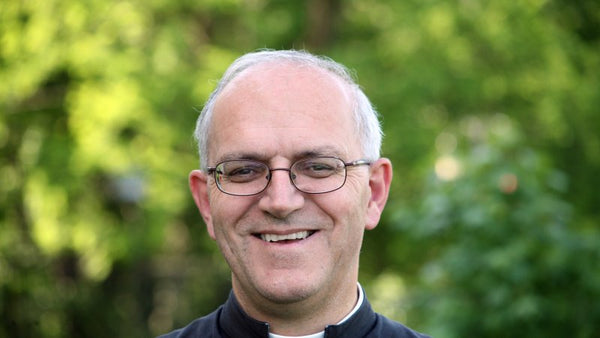The History and Symbolism of Tenebrae
With a dimly-lit church, a rarely-seen candle holder, somber tones, and a candle hidden behind a curtain or the altar, Tenebrae is a unique and special liturgy in the calendar of the Roman Catholic Church.
Most parishioners who live near a church with a community of religious have the opportunity to join them for some or all of the Divine Office on any given day. This common prayer of the Church is said primarily by clerics, on behalf of the laity. It is divided into eight parts – the first being a nocturnal Office (Vigils, later changed to Matins) and 7 Offices of the day: Lauds, Prime, Terce, Sext, None, Vespers and Compline.
During the three days leading up to Easter, also known as the Sacred Triduum, Matins and Lauds are combined together in a special way, and with ancient rubrics, forming Tenebrae. Throughout the history of the Church, Tenebrae was not said in the morning, but in the evening prior, in anticipation of the day to come. The old rubrics do not dictate a specific time, only that it be done “after the hour of Vespers”, but traditionally, it was sung so that the end would arrive close to Midnight, and the completion of the service would be in total darkness. But this changed in the reform of the Holy Week ceremonies by Pope Pius XII in 1955.
The three major liturgies of the Sacred Triduum had been performed during the morning hours. But after this reform, the ceremonies of Maundy Thursday were moved to evening (usually around 6pm), Good Friday’s liturgy was traditionally moved to the sacred hour of Our Lord’s death, and the Easter Vigil was moved from Holy Saturday morning to the nighttime, immediately preceding the Mass at Midnight. This allowed for the Office of Tenebrae to be performed in the early morning of the day, instead of the night before.
![Tenebrae candle hearse, showing successive extinguishing. [Photo Credit: viewfrombackpew.blogspot.com]](http://cdn.shopify.com/s/files/1/1527/1691/files/tenebraecandle_large.jpg)
[Photo Credit: viewfrombackpew.blogspot.com]
The ceremony of Tenebrae is similar during each of the three days. During the first (Matins) part, there are three nocturnes, each with three Psalms, a versicle and response, the Pater Noster, and readings. During the second (Lauds) section, one will hear five Psalms, a versicle and response, and the Benedictus Canticle, which is the song of thanksgiving given by Zachary upon the occasion of the circumcision of his son, John the Baptist. Following this, another Pater, and a reflection on the death of Our Lord, Respice quaesumus.
The rubric is fascinating. In older times, the church would of course, be in near-darkness, since the Office didn’t begin until about 9 or 10 in the evening.
The only light traditionally came from the Tenebrae hearse, or large candle holder. This was placed in the choir, with fifteen lit candles. Some locations use beige candles for all except the top candle, which symbolizes Our Lord Jesus Christ. After each of the Psalms – nine for Matins and five for Lauds – the bottom-most candle is extinguished, alternating sides.
Not only does this rubric slowly bring the church closer to complete darkness, and the time in the Office when the death of Our Lord is commemorated, but it provides a stark visual that Our Lord is slowly but surely left alone in the darkness of the world, fraught with sin.
At the end of the final lesson, the final candle is removed by a server or cleric, and hidden behind a curtain or the altar, signifying the burial of Our Lord in the tomb. A noise is made, symbolizing the earthquake at the Crucifixion. In some locations, the celebrant simply slams his book shut, and in others the clerics and congregation knock on their pews for a time. The candle is finally extinguished, and replaced on the hearse.
The Office comes to an abrupt end, without the usual blessing. The clergy and the faithful leave the Church in silence, without hymn.
While the majority of the ceremonies of the Catholic Church are joyous and celebratory, Tenebrae stands in stark contrast. Even the ceremonies of Holy Thursday and Good Friday contain some consolation… On Holy Thursday, the altar of repose is decorated, and we can keep company with Our Lord. On Good Friday, the crucifixes are finally unveiled, and we can kiss the feet of Our Lord, and receive Him in the Eucharist. But Tenebrae is sorrowful, from beginning to end, complete with darkness, earthquake, and Our Lord symbolically hidden from our view.
Truly a contrast, and an important reminder of this most sacred of weeks.
Leave a comment
Comments will be approved before showing up.
Also in Angelus Press Blog

Angelus Press Website Update is Complete

Angelus Press Website Updates for Wholesale Accounts

Fr. Dominique Bourmaud Passes Away
With great sadness, the U.S. District of the Society of Saint Pius X (SSPX) announces the passing of Fr. Dominique Bourmaud. He went to his eternal reward in the early hours of Saturday, September 4, 2021.
Eternal rest grant unto Fr. Dominique Bourmaud, O Lord, and let perpetual light shine upon him. May he rest in peace. Amen.

Brent Klaske
Author
Director of Operations at Angelus Press. I have worked in Catholic publishing for more than 20 years. I currently live near St. Marys, KS with my wife and 10 children.